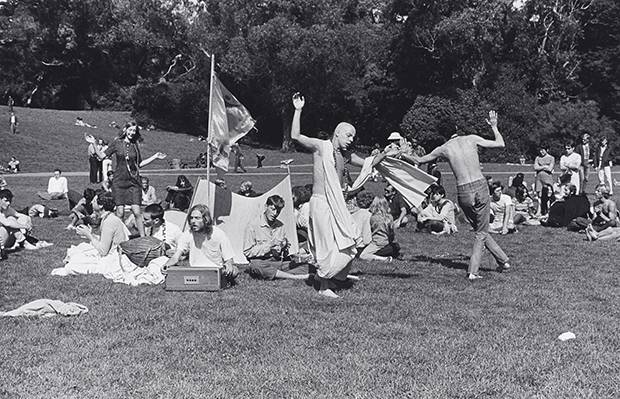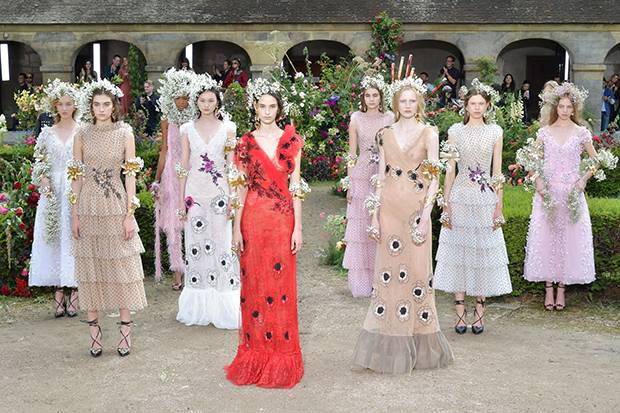The runways during Paris haute couture week in July were clearly inspired by the summer of love. Dior's patchwork velvet coats took cues from Jimi Hendrix's own, while Rodarte's floaty dresses worn by models garlanded with flowers recalled folkie Mimi Baez Fariña's Big Sur wedding to Milan Melvin. On the Fall 2017 ready to wear runways, there were also layers of floral brocade, paisley prints and tie-dye in the collections of Tadashi Shoji and Libertine.
The bohemian, flower power era is repeating itself – and not just in San Francisco, where The Summer of Love Experience, running until Aug. 20, at the city's Fine Arts Museum surveys its famous 1967 hippie moment from a number of perspectives. Its legacy lives on, distilled in fashion and boiled down to a syrupy reduction.
Yet the summer of love – a now much-mythologized title no social movement or moment could wish upon itself – in reality played out quite differently elsewhere. Just across the bay in Oakland, California, the Black Panthers assembled, complete with a radical urban style that set them apart from from hippies and the mainstream: the black leather jacket and matching beret worn with a Free Huey button on the left lapel. And across the country, in Detroit, a fatal riot raged. The incident is dramatized in Kathryn Bigelow's new movie, Detroit.
Canada at the time was largely gripped by Montreal's Expo 67 and centennial celebrations. But inspired by Timothy Leary and Allen Ginsberg's similar assembly in Golden Gate Park, Vancouver's Stanley Park hosted the country's first Human Be-In and the city's beachside Kitsilano neighborhood became a hippie hangout. Similarly, Toronto's Yorkville community became known for its iconic folk music scene.

Ruth-Marion Baruch’s photo Hare Krishna Dance in Golden Gate Park, Haight Ashbury (1967) captures the hippie scene in San Francisco and is part of the exhibition The Summer of Love Experience, on now at the city’s de Young museum.
Ruth-Marion Baruch/COURTESY OF THE FINE ARTS MUSEUMS OF SAN FRANCISCO
In her lively upcoming memoir Behind the Seams, Detroit-raised Canadian fashion designer Marilyn Brooks documents the bohemian era from 1963 to 1970, when she and husband John ran a popular Toronto boutique called Unicorn. The marigold yellow shop on Cumberland Street was a hub of eccentricities, cool finds and homegrown style. Purchases were toted away in a personalized magenta shopping bag. It was a precursor to London's celebrated fashion emporium Biba and, typographically, halfway between that throwback to Art nouveau and the indelible "nouveau frisco" graphic design style inspired by both the Vienna Secession and the psychedelic aesthetic that poster artists were using to promote concerts at the Fillmore auditorium in San Francisco.
For Brooks as a retailer at Unicorn, then in her subsequent decades as a designer, theatricality and delight in combining unexpected, unusual and eccentric elements came together as a successful fashion formula. At a time of homogeneity, it was retail counterculture. More than fifty years later, retailers have gone back to emphasizing the allure of the in-store experience and assortment and exclusivities, too.
The golden anniversary of the summer of love falls at a time when dissent and resistance is a more significant part of the current zeitgeist than even style is, which makes channelling 1960s motifs especially apt for current fashion. If you look beyond the groovy fonts, tie dye and trippy swirls, the origins of the era's look were the aesthetics of protest. Peaceful, but not passive, protest. The original movements targeting social and political injustice overlap all too closely with current ones.
The summer of love's anti-establishment clothing and design didn't operate within the current capitalist system. Graphic design was not crisp, clean or easy to read at a glance, in opposition to the tastes and practices of Madison Avenue, and the crocheted, tie-dye, Tibetan textile imports cut into pants and secondhand clothing thrifted in Haight-Ashbury eschewed the mainstream.
Body and clothing were used as the medium of protest, the same grassroots and homemade take that informed punk and, more recently, the pink knit toques at Women's Marches and homemade Black Lives Matter T-shirts worn as placards.
It's ironic that designer fashion should be posing counterculture codes and unwittingly messaging a moment that, among other things, took aim at the very materialism it espouses. The runways are awash in throwback peace signs, patchwork feathers and fringe and catchy buttons declaring "Love is a Four Letter Word." But if style and slogans without substance were effective, we wouldn't find ourselves in much the same political and social turmoil 50 years later.
Visit tgam.ca/newsletters to sign up for the Globe Style e-newsletter, your weekly digital guide to the players and trends influencing fashion, design and entertaining, plus shopping tips and inspiration for living well. And follow Globe Style on Instagram @globestyle.
